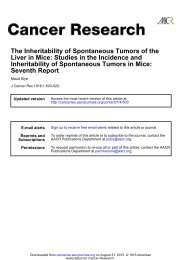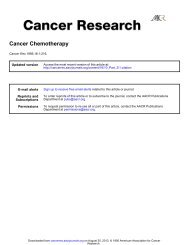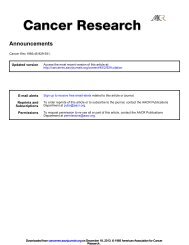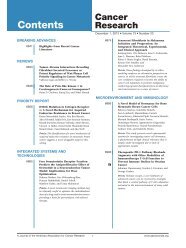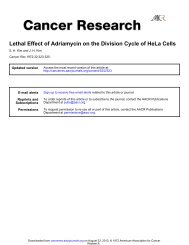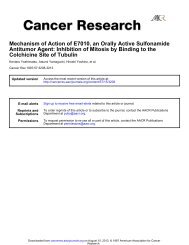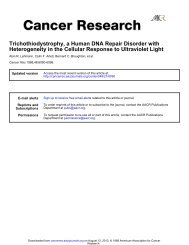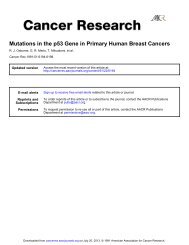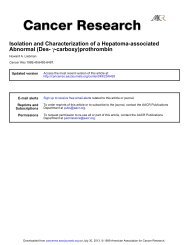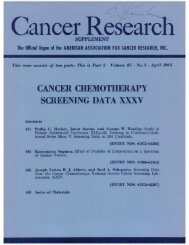Selective Effects by Valinomycin on Cytotoxicity ... - Cancer Research
Selective Effects by Valinomycin on Cytotoxicity ... - Cancer Research
Selective Effects by Valinomycin on Cytotoxicity ... - Cancer Research
You also want an ePaper? Increase the reach of your titles
YUMPU automatically turns print PDFs into web optimized ePapers that Google loves.
dependent <strong>on</strong> cell density (without applicati<strong>on</strong> of VAL) and thus<br />
exhibit features of "unbalanced growth" (29, 30). We have not<br />
yet obtained data <strong>on</strong> the rRNA c<strong>on</strong>tent of these cells under the<br />
acti<strong>on</strong> of VAL but would expect that they also exhibit unbalanced<br />
growth under these c<strong>on</strong>diti<strong>on</strong>s.<br />
Multiple studies have shown that fairly high c<strong>on</strong>centrati<strong>on</strong>s<br />
(>1 ÿM) of VAL are required to affect 1C transport through the<br />
plasma membrane (31, 32). Mitoch<strong>on</strong>drial functi<strong>on</strong> is much more<br />
sensitive to VAL; here, c<strong>on</strong>centrati<strong>on</strong>s of about 7 to 70 nw have<br />
been found to affect the mitoch<strong>on</strong>drial membrane potential (13,<br />
33). In order to arrive at meaningful comparis<strong>on</strong>s between effec<br />
tive VAL c<strong>on</strong>centrati<strong>on</strong>s of different studies, the str<strong>on</strong>gly lipophilic<br />
nature of this compound must be taken into account. The<br />
partiti<strong>on</strong> coefficient of VAL between phospholipid and water has<br />
been determined in bilayer studies and was found to be in the<br />
range of 10" to 10s (34). Using the data given in Ref. 13, we<br />
have a nearly saturating effect of VAL at 10 ¿¿g VAL/g mitoch<strong>on</strong><br />
drial protein suspended at 7 mg protein/ml, yielding an overall<br />
c<strong>on</strong>centrati<strong>on</strong> of VAL of about 70 nw. Taking into account 200<br />
tig lipid/mg protein for these mitoch<strong>on</strong>dria (35) and a lipid density<br />
of about 0.5 g/ml, we arrive at an effective c<strong>on</strong>centrati<strong>on</strong> of<br />
about 25 UM VAL in mitoch<strong>on</strong>drial<br />
nearly saturating effect if a partiti<strong>on</strong><br />
lipid under c<strong>on</strong>diti<strong>on</strong>s of a<br />
coefficient of 104 to 105 is<br />
used. If VAL is applied to cell cultures, it is partiti<strong>on</strong>ed between<br />
water and all lipid phases present, such as serum lipids and<br />
cellular lipids. Using cellular lipid c<strong>on</strong>tents determined earlier (36),<br />
a serum c<strong>on</strong>centrati<strong>on</strong> of 5% with total lipid at 2.5 mg/ml serum,5<br />
a lipid density of 0.5 g/ml, and a partiti<strong>on</strong> coefficient of 104 to<br />
105 for VAL in all lipids, we arrive at c<strong>on</strong>centrati<strong>on</strong>s of VAL in<br />
(mitoch<strong>on</strong>drial) lipid of 8 to 80 MMat overall VAL c<strong>on</strong>centrati<strong>on</strong>s<br />
of 2 to 20 nw, respectively. Thus, the effective VAL c<strong>on</strong>centra<br />
ti<strong>on</strong>s in (mitoch<strong>on</strong>drial) lipid under the c<strong>on</strong>diti<strong>on</strong>s of our present<br />
measurements are identical <str<strong>on</strong>g>by</str<strong>on</strong>g> order of magnitude with those<br />
found to be effective in reducing mitoch<strong>on</strong>drial membrane poten<br />
tial (13), whereas much higher c<strong>on</strong>centrati<strong>on</strong>s were needed to<br />
affect K+ transport through the plasma membrane (31, 32).<br />
Further arguments for a mitoch<strong>on</strong>drial site of acti<strong>on</strong> of VAL stem<br />
from experiments6 <strong>on</strong> analogous proliferati<strong>on</strong>-inhibiting effects of<br />
mitoch<strong>on</strong>drial uncouplers, such as m-chlorocarb<strong>on</strong>yl-cyanide<br />
phenylhydraz<strong>on</strong>e, at about 10 fiM and <strong>on</strong> the fast and substantial<br />
inhibiti<strong>on</strong> of mitoch<strong>on</strong>drial uptake of the cati<strong>on</strong>ic fluorescent dye<br />
rhodamine 123 up<strong>on</strong> cellular treatment with 20 nw VAL. Our<br />
data given in Table 1 are also c<strong>on</strong>sistent with this interpretati<strong>on</strong>,<br />
because the ATP c<strong>on</strong>tent of all cells tested decreases <str<strong>on</strong>g>by</str<strong>on</strong>g> about<br />
30% up<strong>on</strong> treatment with 20 nw VAL.<br />
In order to account for the selective toxic effect of VAL <strong>on</strong><br />
virus-transformed cells (in the presence of n<strong>on</strong>selective effects<br />
<strong>on</strong> ATP c<strong>on</strong>tent), the following possibilities may be discussed. If<br />
the acti<strong>on</strong> of VAL is mediated via a decrease of cellular ATP<br />
c<strong>on</strong>tent, different cell lines may react differentially to an about<br />
equal decrease of cellular ATP. In this c<strong>on</strong>text, it is of interest<br />
that in both reticulocytes and ascites tumor cells a decline of<br />
cellular ATP level <str<strong>on</strong>g>by</str<strong>on</strong>g> 30% leads to inhibiti<strong>on</strong> of protein synthesis<br />
(37). Alternatively, VAL may act differently <strong>on</strong> the mitoch<strong>on</strong>drial<br />
c<strong>on</strong>tributi<strong>on</strong> to intracellular Ca2+ homeostasis (8, 16). Cellular<br />
ATP c<strong>on</strong>tents may be adjusted <str<strong>on</strong>g>by</str<strong>on</strong>g> c<strong>on</strong>comitant stimulati<strong>on</strong> of<br />
glycolysis (38, 39). We have started work to test this sec<strong>on</strong>d<br />
possibility <str<strong>on</strong>g>by</str<strong>on</strong>g> characterizing the effect of VAL <strong>on</strong> intracellular<br />
calcium compartments. By analysis of 45Ca efflux, 3 kinetic<br />
calcium compartments may be separated (40), whereas the<br />
GROWTH INHIBITION AND CYTOTOXICITY BY VAL<br />
intracellular free Ca2+ c<strong>on</strong>centrati<strong>on</strong> may be determined using<br />
the fluorescent indicator Quin 2 (41). For 3T3 cells, all of these<br />
calcium pools were shown to decrease significantly <str<strong>on</strong>g>by</str<strong>on</strong>g> treatment<br />
with 20 nw VAL;7 the transformed cell lines are investigated<br />
presently. In additi<strong>on</strong>, the effect of VAL <strong>on</strong> the following cellular<br />
reacti<strong>on</strong>s appears to represent fruitful issues for further study:<br />
interplay between glycolysis and oxidative phosphorylati<strong>on</strong> (37,<br />
38); protein synthesis (37, 42); polyamine metabolism (43); and<br />
rRNA metabolism (Ref. 14; own unpublished results briefly dis<br />
cussed above). Studies <strong>on</strong> the exploitati<strong>on</strong> of the cycle phasespecific<br />
arrest of tumor cell proliferati<strong>on</strong> also appear to be useful<br />
and are in progress in our laboratory using in vitro and in vivo<br />
systems.<br />
ACKNOWLEDGMENTS<br />
We wish to thank Dr. F. Gruber for collaborati<strong>on</strong> and advice in animal experi<br />
ments, Dr. G. Stark for discussi<strong>on</strong>, and F. Braun and A. Kesper for their excellent<br />
technical assistance.<br />
REFERENCES<br />
CANCER RESEARCH VOL. 45 JULY 1985<br />
1. Bartholomew, J. C., Yokota, H., and Ross, P. Effect of serum <strong>on</strong> the growth<br />
of Balb 3T3 A31 mouse fibroblasts and an SV40-transformed derivative. J.<br />
Cell. Physid., 88: 277-286, 1976.<br />
2. Pardee, A. B. A restricti<strong>on</strong> point for c<strong>on</strong>trol of normal animal cell proliferati<strong>on</strong>.<br />
Proc. Nati. Acad. Sci. USA, 71:1286-1290, 1974.<br />
3. Prescott, D. M. Regulati<strong>on</strong> of cell reproducti<strong>on</strong>. <strong>Cancer</strong> Res., 28:1815-1820,<br />
1968.<br />
4. Schiaff<strong>on</strong>ati, L, and Baserga, R. Different survival of normal and transformed<br />
cells exposed to nutriti<strong>on</strong>al c<strong>on</strong>diti<strong>on</strong>s n<strong>on</strong>permissive for growth. <strong>Cancer</strong> Res.,<br />
37:541-545,1977.<br />
5. Pardee, A. B. Molecular mechanisms of the c<strong>on</strong>trol of cell growth in cancer.<br />
In: C. Nicolini (ed.), Cell Growth, pp. 673-714. New York: Plenum Publishing<br />
Corp., 1982.<br />
6. Paul, D., Henahan, M., and Walter, S. Changes in growth c<strong>on</strong>trol and growth<br />
requirements associated with neoplasie transformati<strong>on</strong> in vitro J. Nati. <strong>Cancer</strong><br />
lnst.,53: 1499-1503,1974.<br />
7. Pedersen, P. L. Tumor mitoch<strong>on</strong>dria and the bioenergetics of cancer cells.<br />
Prog. Exp. Tumor Res., 22: 190-274, 1978.<br />
8. Bygrave, F. K. Mitoch<strong>on</strong>dria and the c<strong>on</strong>trol of intracellular calcium. Bid. Rev.,<br />
53:43-79,1978.<br />
9. Bernal. S. D., Lampidis, T. J., Mclsaac, R. M., and Chen, L. B. Anticarcinoma<br />
activity in vivo of rhodamine 123, a mitoch<strong>on</strong>drial-specific dye. Science (Wash.<br />
DC), 222:169-172,1983.<br />
10. Lampidis, T. J., Bernal, S. D., Summerhayes, I. C., and Chen, L. G. <str<strong>on</strong>g>Selective</str<strong>on</strong>g><br />
toxicity of rhodamine 123 in carcinoma cells in vitro. <strong>Cancer</strong> Res., 43: 716-<br />
719,1983.<br />
11. Summerhayes, I. C., Lampidis, T. J., Bernal, S. D., Nadakavukaren, J. J.,<br />
Nadakavukaren, K. K., Shepherd, E. L., and Chen, L. B. Unusual retenti<strong>on</strong> of<br />
rhodamine 123 <str<strong>on</strong>g>by</str<strong>on</strong>g> mitoch<strong>on</strong>dria in muscle and carcinoma cells. Proc. Nati.<br />
Acad. Sci. USA, 79: 5292-5296, 1982.<br />
12. C<strong>on</strong>over, T. E., and Azz<strong>on</strong>e, G. F. The generati<strong>on</strong> and role of the electric field<br />
in (iH* formati<strong>on</strong> and ATP synthesis. In: C. P. Lee, G. Schatz, and G. Dallner<br />
(eds.), Mitoch<strong>on</strong>dria and Microsomes, pp. 481-528. Reading, MA: Addis<strong>on</strong><br />
Wesley Publishing Co., 1981.<br />
13. Mitchell, P., and Moyte, J. Estimati<strong>on</strong> of membrane potential and pH difference<br />
across the cristae membrane of rat liver mitoch<strong>on</strong>dria. Eur. J. Biochem., 7:<br />
471-484, 1969.<br />
14. Panchenko, L. F., Stelletskaya, N. V., Syrota, T. V., Bokh<strong>on</strong>'Ko, A. I., and<br />
Schuppe, N. G. <str<strong>on</strong>g>Effects</str<strong>on</strong>g> of inhibitors of energetic metabolism <strong>on</strong> RNA turnover<br />
in animal cells. Biochim. Biophys. Acta, 299: 103-113,1973.<br />
15. Pfaff, E., and Klingenberg, M. Adenine nucleotide translocati<strong>on</strong> of mitoch<strong>on</strong>dria.<br />
1. Specificity and c<strong>on</strong>trol. Eur. J. Biochem., 6: 66-79,1968.<br />
16. Nichoiis. D. G. The regulati<strong>on</strong> of extramitoch<strong>on</strong>drial free calcium i<strong>on</strong> c<strong>on</strong>centra<br />
ti<strong>on</strong> <str<strong>on</strong>g>by</str<strong>on</strong>g> rat liver mitoch<strong>on</strong>dria. Biochem. J., 176: 463-474,1978.<br />
17. Azz<strong>on</strong>e, G. F., Pozzan, T., and Massari, S. Prot<strong>on</strong> electrochemical gradient<br />
and phosphate potential in mitoch<strong>on</strong>dria. Biochim. Biophys. Acta, 570: 307-<br />
315,1978.<br />
18. Smith, G. L. Increased ouabain-sensitive "rubidium* uptake after mitogenic<br />
stimulati<strong>on</strong> of quiescent chicken embryo fibroblasts with purified multiplicati<strong>on</strong>stimulating<br />
activity. J. Cell Btol., 73: 761-767,1977.<br />
19. Douros, J., and Suffness, M. New natural products under development at the<br />
7T. Hartmann and G. Adam, unpublished data.<br />
3027<br />
Downloaded from<br />
cancerres.aacrjournals.org <strong>on</strong> December 2, 2012<br />
Copyright © 1985 American Associati<strong>on</strong> for <strong>Cancer</strong> <strong>Research</strong>




